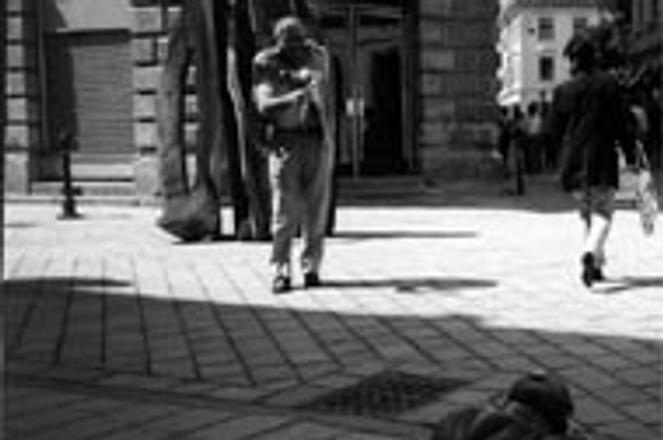A sculpture known as "Čumíl" (the Peeker) has become a symbol of Bratislava's Korzo emerging from the doldrums.Daniel J. Stoll
It has been decades since Bratislava's Staré Mesto (Old Town) was as vibrant as it has been this summer. This is not by accident. City Hall, in cooperation with the Staré Mesto district office and select private developers, is now gathering fruit from a tree whose seeds were sewn years ago.
The area has been largely closed off to cars (indispensable service trucks and snooty embassy vehicles being the exceptions) and key lanes have been laid with paving stones.
But foot-friendly streets alone would not draw the throngs that are clustering there now. That takes something more.
Fortunately for Bratislava Mayor Peter Kresánek, most of the property in the historic core belongs to the city, Staré Mesto district office, or RBI, a development company partly owned by Staré Mesto. This enabled Kresánek to pursue his vision, shared by Staré Mesto district mayor Andrej Ďurkovský, of having tenants who will attract people to the Old Town virtually around the clock.
City Hall has worked hard to sign on entrepreneurs such as those who have opened the Irish pub Dubliner, the pastry shop Kaffee Mayer, and the Interpress newsstand. Each of the three is open at least 12 hours a day, seven days a week, and each is directly on the primary pedestrian route, popularly known as the Korzo.
Far from satisfied, Kresánek, an architecture historian by profession and a reviver by name (kresať means "to spark" in Slovak), is still trying to woo owners of restaurants, cafés, galleries, shops and pensions into specific spots that have been designated for those purposes. Nothing seems to frustrate the mayor more than the proliferation of banks and embassies that have moved into buildings he did not control.
These institutions, in his words, do little to add vitality and much to add headaches, such as parking shortages.
But it is a measure of the mayor's success that banks (including Slovenská Sporiteľňa, ČSOB, Poštová Banka, Istrobanka, Živnostenská Banka, and Dresdner Bank) and embassies (French, Austrian, British, European Union, Hungarian, Polish, Greek) have decided to invest millions of crowns into a neighborhood that was crumbling from neglect less than a decade ago.
As a result of Staré Mesto's reanimated image, rent and sale prices have gone sky-high and few businesses can afford to move in - not to mention private apartments. Kresánek badly wants to keep the historic core from becoming a donut whose insides empty out after dark, but developers argue that it is not economical to reconstruct these old buildings as residences. How this debate will end remains to be seen, but it is unlikely to be resolved before next year's municipal elections.
Although criticized during his 1990-1994 term for lacking executive skills to match his visionary intellect, Kresánek has had more success of late and seems to be growing more confident as a result.
Kresánek's vision is becoming reality. So much so that no lesser critic than the British weekly, The Economist, recently described Bratislava as "quaint." Imagine what they will think when it is finished.


